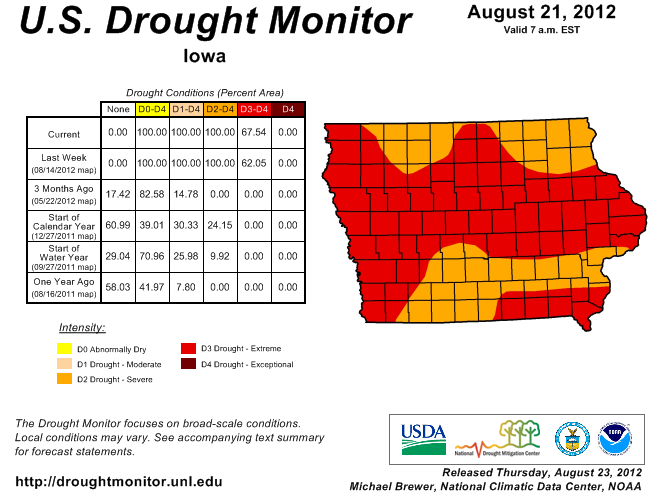2012 Drought
Mills county, Iowa

2012 marked another summer of drought in Mills County’s history. A crop report in August helped show how hard the drought had hit the state. “More than two-thirds of the state’s topsoil and subsoil moisture levels are very short, the report said. More than half of all corn crops are reported poor or very poor, the report said, while less than one-fifth of the state’s pastures are rated in fair or better condition.”
In Glenwood, Iowa, this translated to less than 2 inches of rain in August. Only 0.16 inches of rain fell in July. June was a wetter month with 4.23 inches of rain. However, the totals were all well below Glenwood’s average rainfalls for summer months. Lack of rainfall across the county and high heat created the worst drought in 56 years according to the National Oceanic and Atmospheric Administration. Mills County and 78 other counties in Iowa were declared national disaster areas, making emergency loans available to farmers impacted by the drought.
Mike Hossle, a Mills County farmer, commented on the drought. “There’s corn out there, but some aren’t going to reach 50 bushels (per acre).” The average bushel per acre in Mills county is usually closer to 190. Hossle continued, “I’ve never seen things this bad in my lifetime. I’ve been through dry weather before but nothing like this. The only thing we haven’t had to do is haul water to cows yet.”
Hossle was right. The State Climatologist Harry Hillaker would later describe the drought of 2012 as one of the worst in the state’s history. “This one is worse than 1988. You would have to go back to 1936 to find a drought worse than this one,” he said. But it is not just lack of rain that makes the 2012 drought so damaging; the extreme heat is playing a significant role in how bad the drought gets.
Brian Fuchs, of the National Drought Mitigation Center, commented on the 2012 drought. “Heat makes droughts drier, and droughts make heat hotter.” While there was actually more rain in 2012 than in 1988, the excessive heat in July pushed the 2012 drought to more damaging levels.
A Mills County farmer, Dave Sieck, summed up the uncertainty that comes with prolonged droughts. “A lot of the people I talk to say they don’t know what they have in the fields until they’re getting out there in harvest. Some people are getting good bushels, others aren’t getting even what they hoped they’d get.”
Sources: on-line: “High and Dry: Corn Moping, Farmers Hoping for Rain as Dry Weather Persists,” The Opinion-Tribune, August 2012; “USDA Declares 22 Iowa Counties Disaster Areas,” Wallaces Farmer, May 2013; Love, Orlan, “2012 Iowa Drought Now Worse than ’88,” The Gazette, August 2012; Harry Hillaker,“The Drought of 2012 in Iowa,” Iowa Department of Agriculture and Land Stewardship.
